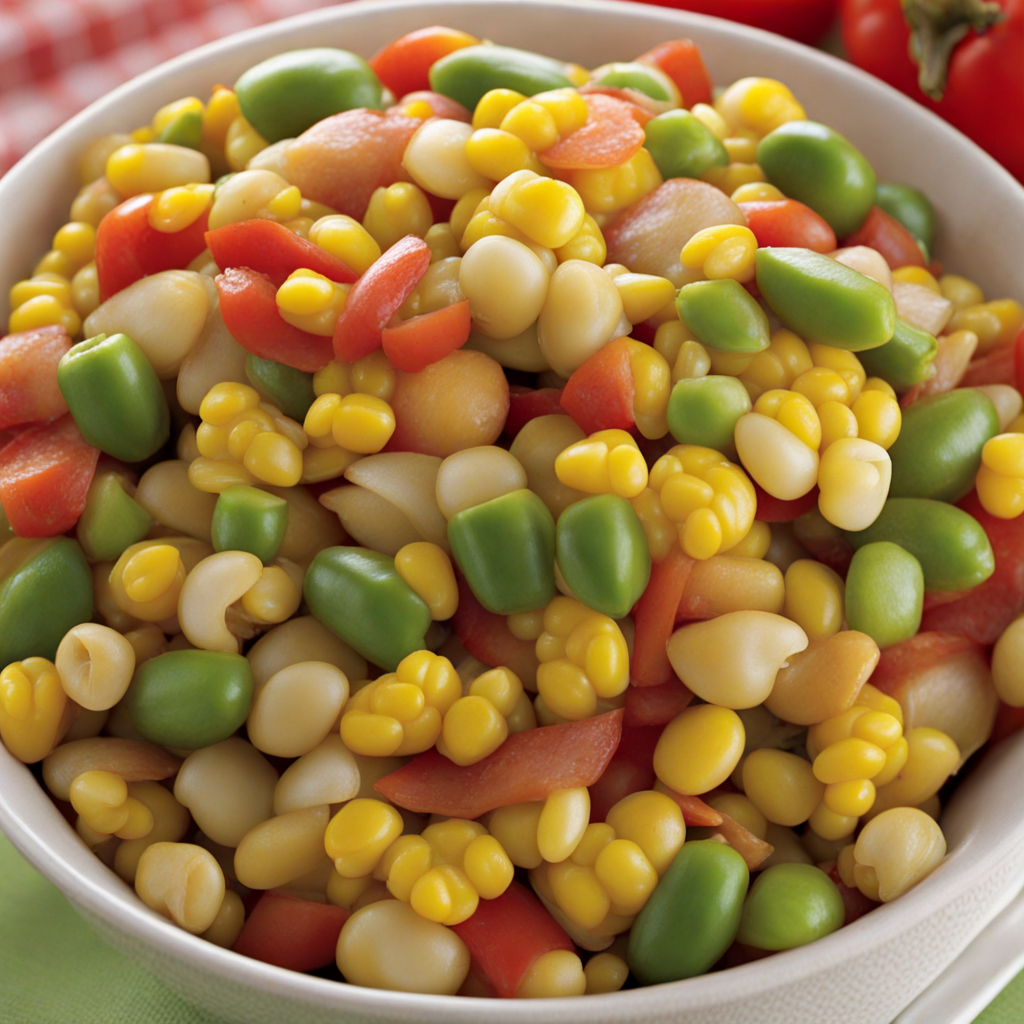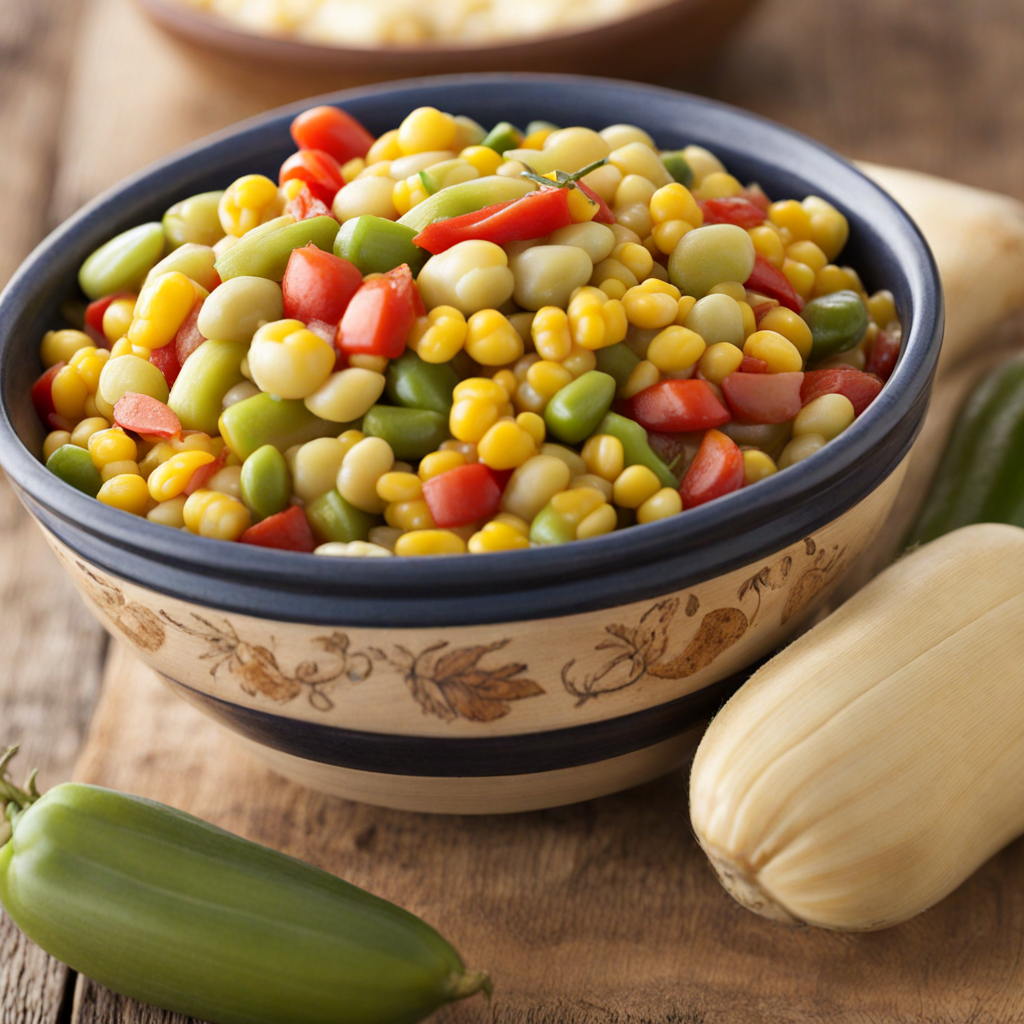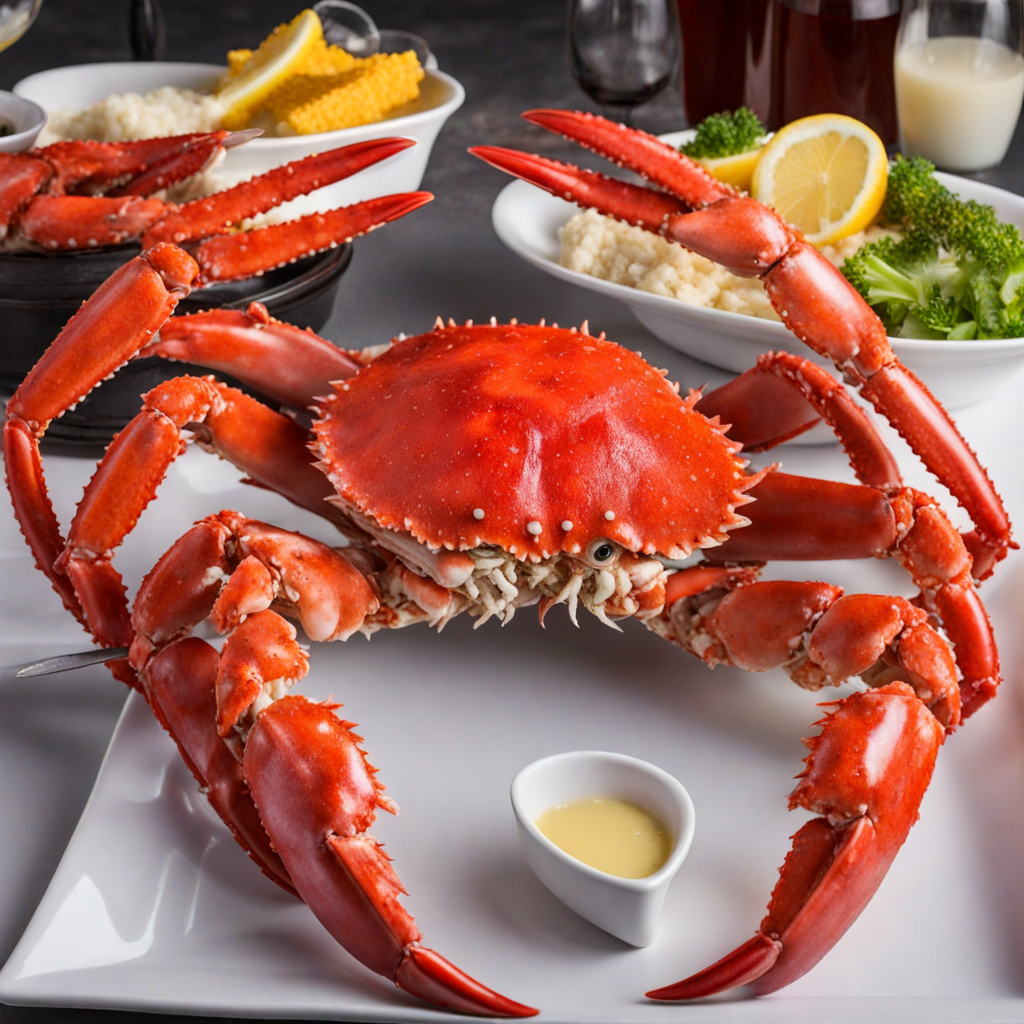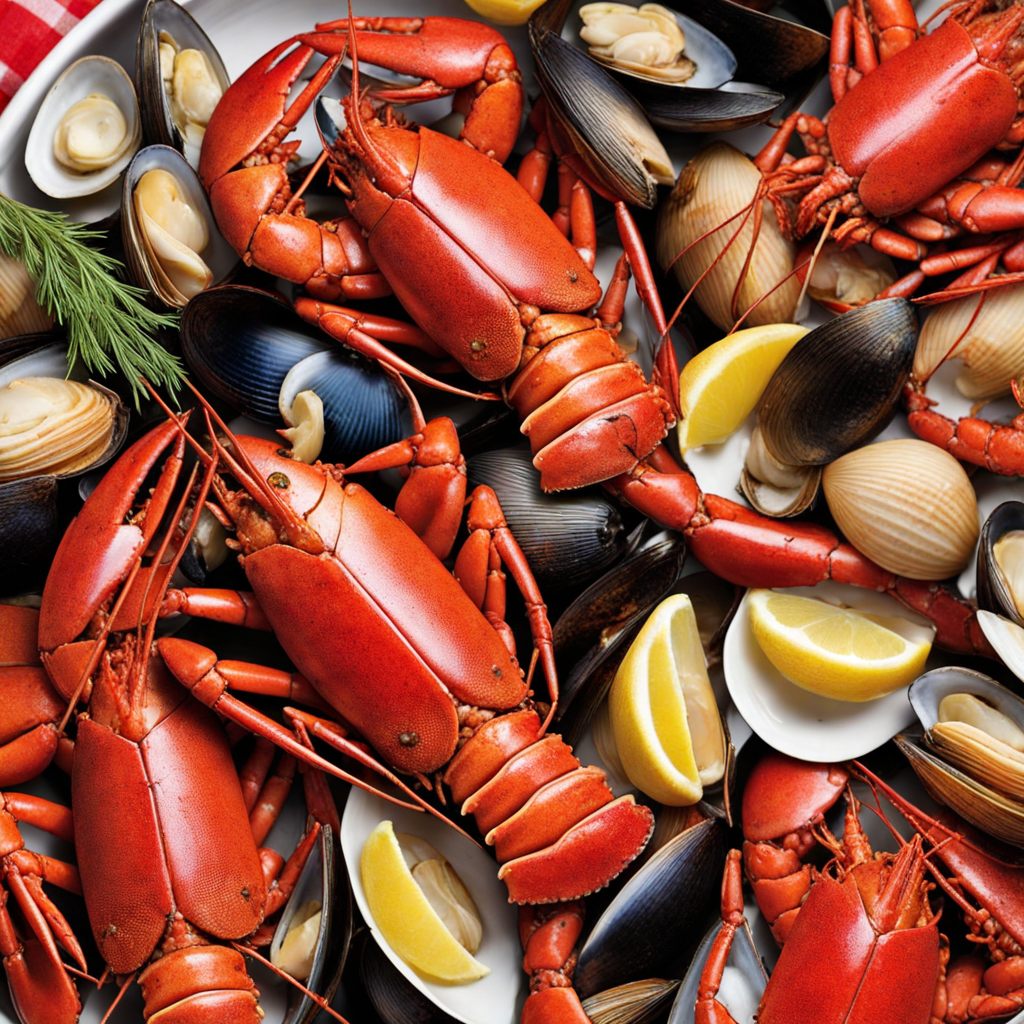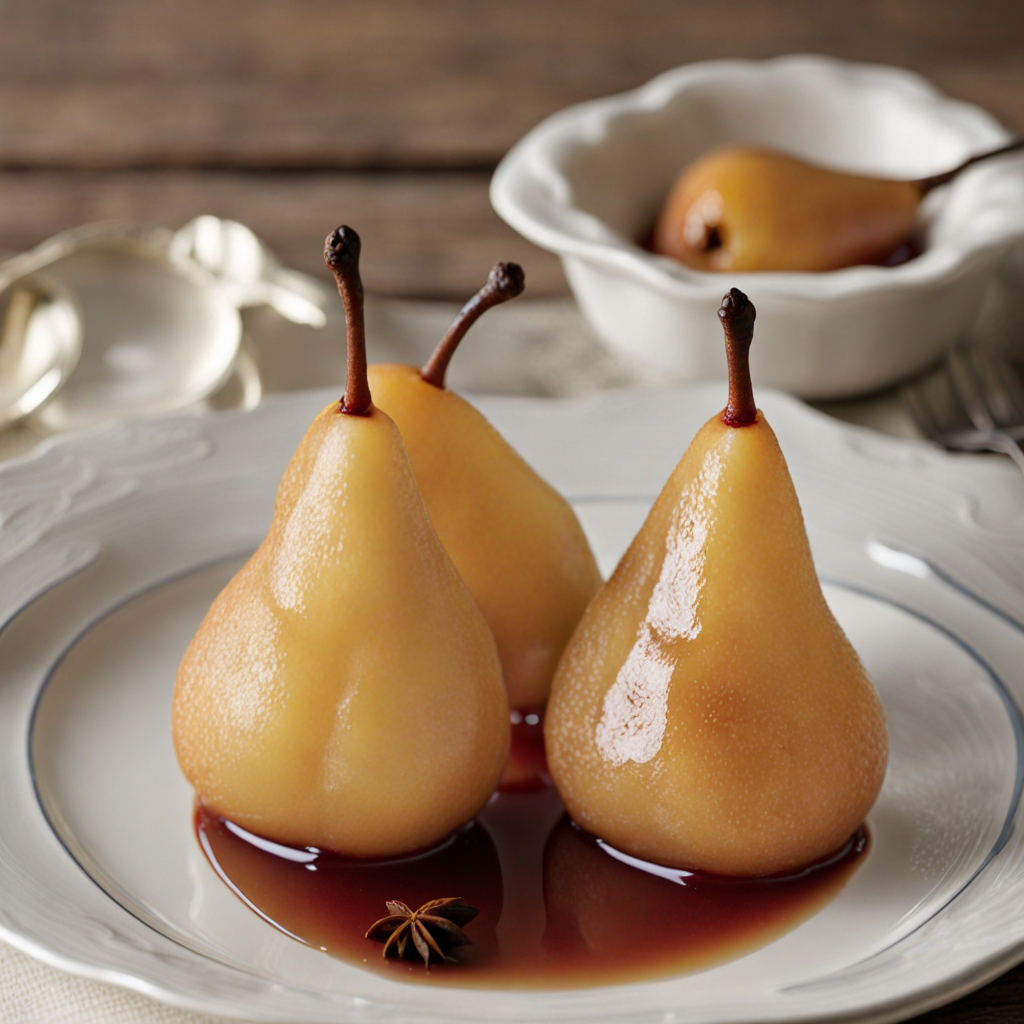Succotash
Succotash is a vibrant and hearty dish that hails from the United States, showcasing a delightful combination of fresh vegetables and legumes. Traditionally, it features a base of sweet corn and lima beans, both of which contribute a sweet and creamy texture. The dish is often enhanced with diced bell peppers, onions, and tomatoes, creating a colorful medley that is as visually appealing as it is flavorful. The blend of these ingredients reflects the rich agricultural bounty of the American South, where succotash has its roots. What sets succotash apart is its versatility; it can be served hot or cold, making it an excellent side dish or a light main course. The natural sweetness of the corn pairs beautifully with the earthy notes of the lima beans, while the added vegetables provide a satisfying crunch. Many variations of succotash incorporate other ingredients such as bacon, herbs, or spices, which introduce additional layers of flavor and complexity. It's a dish that celebrates seasonal produce, making it perfect for summer gatherings or cozy fall dinners. Beyond its delicious taste, succotash is also a dish steeped in history and culture. Originally a Native American staple, it has evolved over the years and become a beloved comfort food among many Americans. The dish embodies the principles of farm-to-table cooking, as it utilizes simple, fresh ingredients that can be easily sourced. Whether enjoyed at a backyard barbecue or as a comforting family meal, succotash offers a unique taste experience that is both nourishing and satisfying.
How It Became This Dish
The History of Succotash: A Culinary Journey through America Succotash is more than just a dish; it embodies the rich tapestry of American culinary history, reflecting the influences of indigenous peoples, African American heritage, and European settlers. This colorful mélange of corn, beans, and sometimes other vegetables encapsulates a story of survival, adaptation, and cultural exchange. #### Origins: Native Roots The origins of succotash can be traced back to the Native American tribes of the Northeastern United States. The word "succotash" itself is derived from the Narragansett word "msickquatash," which means "boiled corn." For Native Americans, corn (maize), beans, and squash—often referred to as the "Three Sisters"—formed the cornerstone of their agricultural practices and diets. These crops were not only staples but also exemplified a sustainable farming method, with each plant complementing the others. Corn provides a natural structure for beans to climb, while beans fix nitrogen in the soil, enriching it for the squash, which in turn spreads out to shade the ground, reducing weeds. Indigenous people prepared succotash in various ways, commonly boiling the ingredients together. They typically used fresh corn and beans when in season, making it a dish that celebrated the bounty of the harvest. The dish was not only a source of nourishment but also a communal experience, often enjoyed during gatherings and celebrations. #### European Influence: The Colonial Era As European settlers arrived in North America, they encountered the indigenous peoples and their agricultural practices. The settlers quickly adopted succotash into their own diets, recognizing the practicality and nutritional benefits of the dish. The incorporation of succotash into colonial cuisine was a testament to the blending of cultures, as European settlers began to add their own ingredients, such as salt pork or other meats, enhancing the dish's heartiness. By the 18th century, succotash had made its way into American cookbooks, often celebrated as a simple yet nutritious meal for families. Notably, it became a staple during the American Revolutionary War, as it was both easy to prepare and could be made with ingredients that were readily available. Soldiers often relied on succotash for sustenance, and its popularity continued to grow. #### 19th Century: A National Dish As America expanded westward in the 19th century, succotash evolved further. The westward movement brought new ingredients and regional variations into play. The dish found its way into the homes of settlers and pioneers who adapted it to their circumstances. In the Midwest, for instance, it often included lima beans, while Southern variations began to incorporate okra and tomatoes, reflecting the agricultural bounty of the regions. The dish was also embraced by African American communities, particularly in the South. Enslaved people and their descendants made succotash using whatever ingredients were available, often adding spices and herbs to enhance the flavor. This adaptation not only showcased the resilience of African American cuisine but also highlighted the ongoing dialogue between different cultural traditions in the American culinary landscape. By the latter half of the 19th century, succotash was firmly rooted in American cooking. It began to appear in cookbooks, such as "The Boston Cooking-School Cook Book" by Fannie Farmer, published in 1896. Farmer’s recipes introduced more structured methods of preparation and encouraged the use of fresh, seasonal ingredients. Succotash’s status as a comfort food was solidified during this era, often associated with home-cooked meals and family gatherings. #### 20th Century: A Symbol of American Identity The 20th century saw succotash experiencing a resurgence in popularity, particularly during the Great Depression when families sought affordable and filling meals. The dish was often made with canned vegetables, making it accessible to those struggling financially. During this time, succotash became a symbol of American resourcefulness, perfectly fitting the ethos of the era. In the post-World War II period, succotash was featured in various advertisements and media, further embedding it into the American consciousness. It was portrayed as a quintessentially American dish, often served alongside fried chicken or barbecued meats. The 1950s and 60s saw its appearance in television shows and cookbooks, reinforcing its status as a comfort food. #### Cultural Significance and Contemporary Variations Today, succotash continues to be a beloved dish, with culinary interpretations reflecting the diverse influences that have shaped it. Chefs and home cooks alike experiment with ingredients, adding a modern twist while honoring its historical roots. Contemporary variations may include ingredients like avocado, bell peppers, or even quinoa, showcasing the dish's adaptability to seasonal produce and dietary trends. Succotash also serves as a culinary metaphor for the melting pot that is America—a dish that embodies the fusion of cultures, traditions, and flavors that define the nation. It is often featured in farm-to-table restaurants, where chefs emphasize the importance of local ingredients and sustainable practices. As a result, succotash has transcended its humble origins to become a dish that celebrates both heritage and innovation. In addition to its culinary journey, succotash holds a special place in American culture. It is often associated with the Thanksgiving meal, serving as a reminder of the harvest and the importance of community. The dish has also been embraced by various regional festivals, where it is celebrated as a symbol of agricultural abundance. #### Conclusion: A Dish with a Legacy Succotash is more than just a medley of corn and beans; it is a dish steeped in history, embodying the resilience and creativity of those who have made it throughout the centuries. From its indigenous roots to its place on modern tables, succotash reflects the ever-evolving narrative of American food culture. As we savor a bowl of succotash today, we partake in a legacy that spans generations and cultures. It serves as a reminder of the interconnectedness of our culinary traditions and the importance of celebrating diversity on our plates. In every bite, we taste not just a dish, but a story—a story of survival, adaptation, and the enduring spirit of community.
You may like
Discover local flavors from United States


